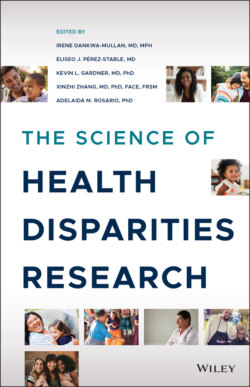Читать книгу The Science of Health Disparities Research - Группа авторов - Страница 58
3.5 Selected Examples of the State of the Science in the Field to Illustrate Best Practices 3.5.1 Exploring Health Disparities in Integrated Communities Study
ОглавлениеThe Exploring Health Disparities in Integrated Communities (EHDIC) study examines health disparities within racially integrated communities among urban Blacks and Whites with similar SES in order to address the issue of confounding between race, SES, and segregation. Confounding by race and SES can be problematic, as health status varies by both factors [26]. The overlap between these factors complicates efforts to understand if it is “race and class” that produces health disparities or “race or class.”
This cohort study collected data through a structured questionnaire and blood pressure measurements from adults in two urban, low‐income, racially integrated contiguous census tracts in southwest Baltimore, Maryland. In order to identify racially comparable communities for the study, the team used the following set of criteria: (i) at least 35% each of Black and White residents, (ii) a ratio of Black to White median income between 0.85 and 1.15, and (iii) a ratio of the percentage of Black to White high school graduates age 25 and above between 0.85 and 1.15. Using these criteria allowed for the examination of health disparities with minimal confounding between race and SES measures, such as income and level of educational attainment [27].
After two contiguous census tracts were selected, every occupied dwelling was identified in the study area, and a letter was mailed to all occupied dwellings to notify residents about the study. Various recruitment methods were used, including door‐to‐door visitation, walk‐ins at the study's administrative office, and community‐based health fairs [27].
The results indicated that Blacks had lower rates of both smoking and fair or poor self‐rated health as compared to Whites. However, no race differences were observed in obesity, drinking, or physical inactivity (see Table 3.4). The results suggest that considering race differences in exposure to social conditions reduces or eliminates some health‐related disparities. Further analyses from the EHDIC study sought to determine if racial health disparities, which are typically reported in national‐level studies, persist when Blacks and Whites live in integrated settings [26]. The study results indicated that nationally reported disparities, including hypertension, diabetes, obesity among women, and use of health services, lessened or disappeared altogether in racially integrated communities. The one exception was smoking, which was higher among White residents. This study demonstrates that racial differences in social environments explain a significant portion of disparities reported in national data, and that when social factors are leveled, racial disparities are reduced.
Table 3.4 Summary of previously published findings from the Exploring Health Disparities in Integrated Communities – Southwest Baltimore Study (EHDIC‐SWB) compared to findings from national surveys.
Source: LaVeist et al. [26]. © 2011, The People‐to‐People Health Foundation, Inc.
| Health‐related outcome | EHDIC‐SWB | National survey | |||
|---|---|---|---|---|---|
| Odds ratioa | 95% CI | Odds ratioa | 95% CI | Major finding | |
| Hypertension | 1.42 | 1.09, 1.86 | 2.01 | 1.63, 2.48 | Racial disparity related to hypertension prevalence smaller in EHDIC‐SWB than in NHANES, but statistically significant |
| Diabetes | 1.07 | 0.71, 1.58 | 1.61 | 1.26, 2.04 | Racial disparity related to diabetes found in NHIS, but not in EHDIC‐SWB |
| Obesity | 1.25 | 0.90, 1.75 | 1.99 | 1.71, 2.32 | Racial disparity related to obesity found in NHIS, but not in EHDIC‐SWB |
| Cigarette smoking | Blacks have lower odds of being current smokers and smoke fewer cigarettes per day compared to Whites in EHDIC‐SWB, but no racial disparity in smoking in NHIS | ||||
| Lifetime smoker | 0.55 | 0.41, 0.72 | 0.62 | 0.49, 0.79 | |
| Current smoker | 0.71 | 0.56, 0.90 | 0.93 | 0.72, 1.21 | |
| Cigarettes smoked per day | 0.68 | 0.61, 0.75 | 0.86 | 0.74, 1.01 | |
| Use of health services | 1.44 | 1.00, 1.87 | 0.74 | 0.51, 1.07 | No disparity in having a medical care visit in MEPS, but more likely to have a visit in EHDIC‐SWB |
CI = confidence interval, NHANES = National Health and Nutrition Examination Survey, NHIS = National Health Interview Survey, MEPS = Medical Expenditure Panel Survey.
a All odds ratios are for the odds of the health‐related outcome among Blacks compared to the odds of the health‐related outcome among Whites [26].
Though the EHDIC study advances our understanding of health disparities, the study was conducted in only two census tracts in an urban population. As a result, the generalizability of the study findings is limited. Conducting this study in nonurban environments or higher SES communities may yield different results. Future studies plan to examine health disparities in different environments.
